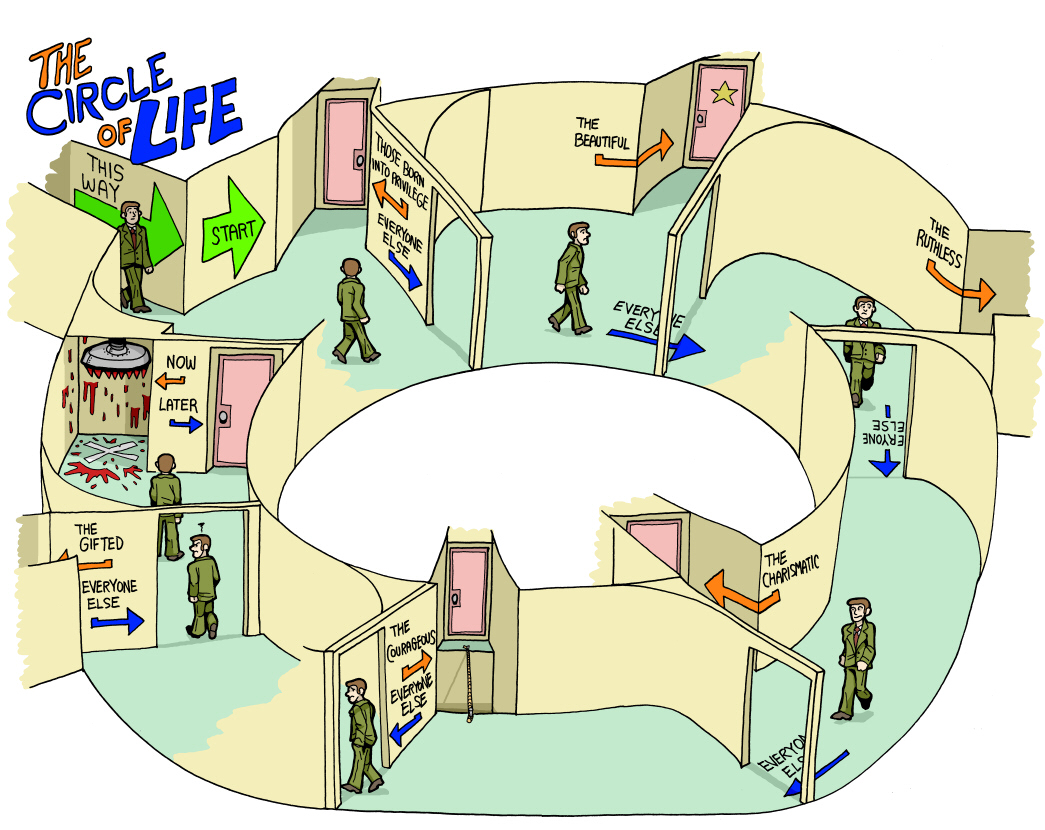20080331
5 Urban Design Proposals for 3D City Farms: Sustainable, Ecological and Agricultural Skyscrapers

Imagine the world in 2050 with almost 80% of the planet’s population living in urban centers and our fruit, vegetables and even animals are grown in … skyscrapers? One man’s vision has sparked a series of designs leading closer and closer to what will be the first real-life vertical urban farm in Las Vegas, Nevada of all places. Here are five of these remarkable architectural designs for sustainable (and stylish) urban farm towers that may revolutionize agriculture as we know it. In the long run such structures may not only provide food for hundreds of thousands of people per building but they will also relieve much of the burden on other flat landscapes where fewer and fewer usable growing spaces exist.
One of the first designs of its kind, the compelling vertical farm project above was undertaken by Chris Jacobs in cooperation with the grandfather of skyscraper farm concepts: Dr. Dickson Despommier of Columbia University. His ideal: all-in-one eco-towers would be actually produce more energy, water (via condensation/purification) and food than their occupants would consume. His mission: to gather architects, engineers, economists and urban planners to develop a sustainable and high-tech wonder of ecological engineering.


Architect Pierre Sartoux of Atelier SOA has gone a step further and put some serious design talent behind his proposal for a vertical farming skyscraper. A light-shading skin wraps around the structure and opens to admit sunlight at particular locations for various functional (and aesthetic) purposes. The building’s air, heating and cooling systems are wind-driven and circulate oxygen and carbon dioxide between growing and living spaces. The simple but reinforced structure is designed to handle additional dead loads from the weight of growing floors and also serve to make the entire building more durable (and thus sustainable).


Given that most urban cores are already densely built, one designer has proposed an auxiliary series of structures to be attached to existing structures in downtown areas. These modular constructions would provide garden and recreation spaces for residents as well as light and air filters for the adjacent buildings. In some cases, these retrofits could even provide structural stability to aged buildings and prevent the need to tear them down. Architecturally, these modular units stand out and add another layer to the visual hierarchy of the cities around them.



The Pacific Northwest regional architecture firm Mithun developed a compelling vertical farm building design to incorporate various green building strategies in a mixed-use residential and commercial complexdesigned for downtown Seattle. The concept? Simply put, the structure is designed as a kind of built organism - completely self-sufficient and adaptive to its surroundings. The design includes water and energy self-sufficiency from rainwater and gray water collection and reuse, solar cells, vegetable and grain growing spaces and even a chicken farm - all built on a small-footprint downtown urban lot.
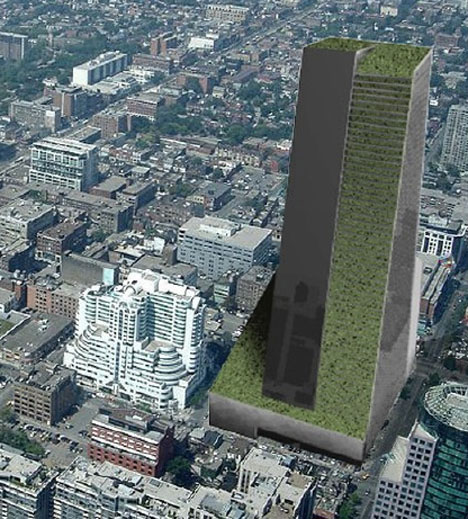

Architect Gordon Graff may succeed in the more green and progressive city of Toronto with his plans for a sky farm with 48 floors and millions of square feet of floor space (and even more growing space). This building, if constructed, will be able to feed tens of thousands of people per year. Best of all, particularly in Canada, the success of the building’s crops isn’t contingent upon climactic conditions. As an architectural and urban design gesture this structure both fits into the city skyline and differentiates itself with simple layers of green.
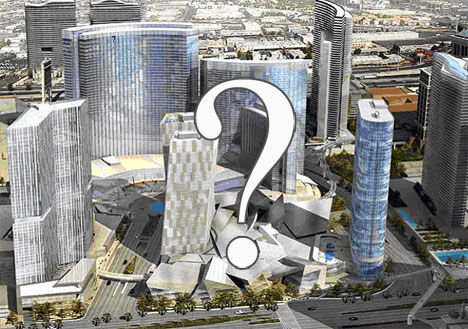
Depending on your point of view Las Vegas might be the first or it could be the last place you’d imagine the 30-story world’s first vertical farm. Of course, the food isn’t going to feed the famished masses. It will instead grace the dinner plates of Vegas tourists at local casinos and hotels. Still, as a prototype it has a lot of potential to generate further buzz and interest that could in turn lead to future projects. If the model proves both profitable and sustainable (always the best combination) it will likely (and hopefully) be the first of many.
Your rights to your self.
<The right to life means nothing to the right to death. Not only did they take away any meaning for his existence, they were violent to him. Fuck the police.>
Karl Rove: 'The tail and the horns are retractable'
Former Deputy White House Chief of Staff Karl Rove, during a speech at George Washington University last night, was interrupted by a group holding up a sign reading "War Criminal."
Amid booing and clapping in the crowd, members can be heard yelling "Tase 'em!" as the protesters are escorted out.
"Why is it that you think you evoke such a visceral reaction in many of your detractors?" asks one audience member, curious to know how said detractors would make a determination that Rove was a "fundamentally bad human being" as a result of his policy decisions.
"Look," Rove responds, "first of all, the tail and the horns are retractable...Look: I'm a myth! I mean, I'm like Grendel of Beowulf; I'm not often seen but people talk about me a lot. I don't know."
Video of the speech is embedded below. More can be read at Think Progress.
The Ravaging Effects of Capitalism on My Hometowns
What will become of Costa Rica? That's the question on my mind, now that my adopted country has narrowly accepted CAFTA. Our national slogan is "Pura vida!" meaning "pure life," and it's commonly used as an affirmation that life is good. It's easy to understand how such an expression could catch on here: Costa Rica has virtually no enemies, a temperate climate, and a hell of a lot of good beaches. However, as an expatriate whose previous hometowns have been despoiled by global capitalism, I find it difficult to imagine that life will be as pure or as good once the effects of CAFTA begin to kick in. At the very least, the treaty will accelerate trends already evident in Costa Rica, such as more corporations like Intel and Procter & Gamble setting up operations. Indeed, CAFTA promises an improved "business climate" and "regulatory environment" for foreign firms and investors, but I wonder what that will mean for Costa Rica's actual landscape, and the people who inhabit it.
I first witnessed the negative effects of global capitalism from the North American side, being from Schenectady, N.Y., the original "home of General Electric," a phrase that resounded through my childhood. Known also as "the city that lights and hauls the world" in its heyday, Schenectady and General Electric grew together during the first half of the 20th century. They remained interdependent, both economically and socially, and when I was growing up in the early 1970s, G.E. was still the biggest employer in town, with about 27,000 workers. It was also the biggest polluter: the more than 1 million pounds of toxic PCBs that it dumped into the Hudson River caused various health problems for local residents, ranging from skin diseases to birth defects -- and probably cancer. In the 1980s, G.E.'s famed CEO Jack Welch initiated an aggressive strategy of eliminating and outsourcing jobs with the result that the company now employs fewer than 4,000 workers in Schenectady.
And where did the outsourced jobs go? Mexico, Malaysia, China, India, you name it. It might appear that Costa Rica will gain only from being among the nations that are insourced, but it has yet to have an industrial force that big move in and seriously befoul its environment. Nor has Costa Rica had the experience of being abandoned by such a transnational when it moves its operations to yet another country that can offer still greater savings.
For more than a decade now, tourism has been Costa Rica's main source of income, currently accounting for 60.4 percent of its GDP. One would think that Costa Rica's president Óscar Arias would do all he can to safeguard the beautiful environment that generates Costa Rica's wealth, but, considering that his administration recently rescinded the moratorium on offshore oil drilling, that does not seem to be the case. Though Costa Rica has protected about 25 percent of its nature areas, and plenty of environmental laws are in place, many of them are either partially enforced or not enforced at all. Furthermore, some of these laws can potentially be challenged under CAFTA, one reason that environmentalists have been united in their opposition to the treaty.
But equally pernicious is the possibility that CAFTA will bring about the demise of the small farms that grow some of our best coffee and produce. That this will be an incalculable cultural loss might be hard for outsiders to understand unless you are one of those tourists who came to Costa Rica for its pristine forests or beaches and fell in love with the people here. I believe that their boundless hospitality has its roots in the strong agricultural tradition whereby, as in bygone years in the United States, neighbors would help each other to bring in the harvest or to raise a barn.
My wife and I live in a coffee-growing region where our town monument depicts a farmer with two oxen pulling a cart full of coffee beans to market. Nearly every day someone does something to reflect this campesino spirit, like yesterday when the grandmother of my son's playmate sent him home with a bag of oranges from the tree in their backyard. A less trifling example is the playground cleanup and repair project initiated by one of our neighbors in which nearly everyone on our block participated. That scene of the adults working together to make things better for the children, while the children frolicked in the grass, helping where they could, is one I'll never forget. The point is that this tight-knit, highly cooperative community will not remain that way for long if it loses its agricultural base.
At present you can buy a mango in Costa Rica for about 50 cents. An apple from the United States, however, costs about 75 cents. The reason is that a tariff equal to the price of the imported fruit is applied, so that it sells here for twice as much as in the United States. CAFTA will eliminate such tariffs and thus cut the prices for imported grains and produce in half. It's unlikely that Costa Rican farmers will be able to compete with U.S. agribusiness, which has not only the advantage of economies of scale, but of massive government subsidies as well.
Bring it on, say the turbo capitalists: If these Costa Rican agricultural workers can't compete in the global marketplace, they should enter another line of work. No matter that Costa Rica's agrarian tradition is a major repository of its folklore, culture and history. No matter that the land means so much to these people. No matter that tens of thousands of visitors tour coffee plantations and other such places each year who won't want to see factories and industrial parks. For the champions of free trade, the invisible hand of the market knows best, and it's just fine if all those farm workers eventually go to work in factories owned by foreigners.
To refute this type of thinking, one need only look at the effects of NAFTA, the earlier free trade agreement with Mexico on which CAFTA is based. Activists warned that NAFTA would displace small farmers and farm workers from the rural life that they had lived for generations and drive them into the cities, where the only way they would be able to survive would be to sell their labor to foreign employers. Organized labor in the United States predicted "a giant sucking sound" as a huge number of U.S. jobs were transferred to a labor force that would not expect the same benefits, rights or protections, and would be willing to work for one-tenth the pay. Environmentalists argued that U.S. corporations would likewise take advantage of Mexico's laxer environmental laws and the lack of enforcement of those laws.
Unfortunately, all these predictions came to pass. A large percentage of farmworkers were displaced from the land, and many of them began working at factories in the cities. Others left Mexico altogether, swelling the ranks of illegal alien workers in the United States. Meanwhile, U.S. jobs were indeed exported to Mexico: the number was between 750,000 and 3,200,000, depending on who is interpreting the statistics. And greater environmental damage occurred than would have been the case had those factories remained in the United States. We not only outsourced jobs, we outsourced environmental destruction, inflicting on Mexico what our laws would not have permitted us to do to our own land, air and water.
But didn't U.S. farmers, at least, benefit from NAFTA? Not farmers with faces and families, according to Kathy Ozer of the National Family Farm Coalition. She cites some telling statistics: "Under NAFTA, we lost 100,000 family farmers between 1996 and 2001. Commodity prices for corn, wheat, and cotton all fell by 20 to 30 percent. But the profits of Archer Daniels Midland (ADM), one of the largest U.S. exporters of corn -- much of it genetically modified, of course, and grown using massive amounts of pesticides -- more than tripled from $110 million in 1994 to $301 million in 2000 to $451 million in 2003. The story is the same for ConAgra and Cargill. Clearly, the big winners are the large processors and grain traders."
And what kind of life awaits those Costa Ricans who would enter the growing industrial sector? Probably not one they would have chosen in the absence of financial exigencies. Even the most prestigious firms exact an undeniable price on the cultural identity of their workers. For example, in our capital city of San Jose, Hewlett-Packard employs thousands of phone agents who sit in cubicles and answer service calls in an environment that might just as well be San Jose, California. You don't have to study the research of Brazilian sociologist Ruy Braga to realize how demoralizing it can be for employees to spend all day in a workplace that subtly or overtly invalidates their collective frame of reference. Along with this comes the calculated imposition of corporate norms that are in certain respects antithetical to the personal values held by most Costa Ricans.
I've never seen an HP personnel manual, but I doubt it bears much resemblance to the social contract here. The smiles of the Costa Rican people arise from a mixture of family values in the best sense of the term and a society that prefers friendly cooperation to aggressive competition. Their graciousness and warmth will prove highly perishable if they have to adhere to such written and unwritten precepts of corporate America as "time is money," "watch your back," and "work comes first."
But the effects of "free trade" will extend far beyond the realm of work. Since I moved here in 2001, the same fast food franchises that have aggravated the health and weight problems of millions in the United States have appeared on streets that previously contained only little lunch places serving rice, beans and tortillas. In another development, the first big malls have been erected. I wonder what family-run stores they will put out of business, as Costa Ricans flock to Nike and Tommy Hilfiger. On yet another front, Wal-Mart, in what is no doubt the beginning of a marketing plan to conquer Costa Rica, recently acquired two of our most popular supermarket chains.
I have a sinking fear that Wal-Marts will one day be seen in close proximity to some of Costa Rica's most prized nature reserves, for I have already witnessed this same cycle play out in the United States: malls and box stores where local businesses used to be, or even where nature used to be. When I lived in Ithaca, N.Y., Wal-Mart wanted to build across from Buttermilk Falls State Park. This was a place I often went swimming in the summer; the frothy water plunges down from 600 feet into a natural basin with a surrounding patio of shale on which I would soak up the sun. Buttermilk was one of those places you'd go to clear your mind and forget about the world -- until suddenly the world's most powerful retailer wanted to mess with it.
If the city refused Wal-Mart the choice spot, the corporation threatened to build outside the city limits, as several malls had already done, thus further eroding the municipal tax base. Yet, who would want to hike up the scenic trail at Buttermilk Falls to be rewarded with a view of Wal-Mart? Some very knowledgeable citizens scrutinized the environmental impact report and pointed out numerous unresolved problems during countless meetings at city hall and elsewhere. In the end, Wal-Mart abandoned plans for the site -- though not before unsuccessfully suing the city.
But then Ithaca elected a new mayor who quietly entered into negotiations to construct what turned out to be a Home Depot in the very same spot. Ithaca's citizens were not informed until after building preparations had begun, and those who protested were simply ignored. Never mind that the environmental impact report raised serious concerns. The mayor had already moved on to Wal-Mart, and soon announced that the megacorporation would be constructing a store in a nearby wooded area.
What happened in Ithaca is but one small example of the way that Big Business and its representatives in government often get things done these days -- all around the world. In Costa Rica, it came as no surprise that all the large firms were solidly behind CAFTA and didn't hesitate to pressure their employees to vote for it. Those same firms also provided enormous political and economic backing for Óscar Arias, who ran on a pro-CAFTA platform in 2006. Arias was elected by a margin almost as slight as Bush vs. Gore in 2000; after taking power he nevertheless asserted, as Bush did, that he now had a mandate. He appointed a staunchly pro-CAFTA staff, and, like that mayor of Ithaca, expressed no interest in engaging in open debate about an issue that had divided the public like no other in recent decades.
The Arias administration's true colors were further revealed shortly before the CAFTA referendum vote when a confidential memo to the president was leaked to the University of Costa Rica newspaper. In it, Second Vice President Kevin Casas and Fernando Sánchez, a powerful legislator, wrote: "The coalition against us is formidable: universities, the church, environmental groups, etc. And on the other side, there is only the government and some of the big entrepreneurs." To win over the people, they detailed a profoundly unethical pro-CAFTA strategy that included a proposal to threaten Costa Rica's mayors with a funding freeze if CAFTA was voted down in their districts, and a Rove-style fear and smear campaign.
Casas was forced to resign completely; Sánchez, who happens to be Óscar Arias' cousin, remains in the legislature but has been removed from the two committees he chaired: elections and banking. It is disconcerting to think that if these two men had mastered, even in part, the techniques of stealth utilized so successfully by the Bush administration, they would still be at their posts. Actually, all they needed was to heed a bit of advice offered with levity by Dick Cheney when he spoke last September at the Gerald R. Ford Presidential Library. After making an aside about researchers who dig through the correspondence of key political figures, Cheney said, in regards to himself, "I want to wish them luck, but the files are pretty thin. I learned early on that if you don't want your memos to get you in trouble some day, just don't write any."
Cheney's aversion to public scrutiny is, of course, shared by Bush, and was evident in the CAFTA process. During the negotiations, a coalition of more than sixty nongovernmental organizations -- most of them U.S.-based -- signed an open letter calling for greater transparency and civil society participation. Indeed, a quick glance at the committee advising the president and Congress on environmental issues relating to CAFTA tells the story: only five out of the 29 members were associated with public environmental organizations, six if you want to include the Garden Clubs of America. Facing them off were representatives from such corporations as Agrisystems International, the Carlyle Group, General Motors and Harken Energy, which had recently filed for arbitration against Costa Rica for refusing to allow it to drill along the protected Talamanca Coast. Like Wal-Mart in Ithaca, Harken's response to failing an environmental impact review was to sue.
It seems as if these and other transnationals have taken over the United States, which is one reason I wouldn't want to move back. In any event, the hometowns I used to know no longer exist. Once proud Schenectady currently has a hollowed out feeling, and a crime rate that has soared as its economy has plummeted. And in Ithaca, the road that runs alongside Buttermilk Falls as you enter the city is now a congested wasteland of parking lots and big-box stores. By the way, the PCBs that General Electric dumped into the Hudson River have yet to be fully removed, and you still can't swim in the river or eat the fish. Attempts to legally force G.E. to undertake dredging have met with formidable resistance. Home wrecker!
Meanwhile, back in our little village in Costa Rica, it's Friday morning -- which means the farmers' market is in progress over by the elementary school. About 40 farmers show up each week and set up stalls from which they sell a cornucopia of vegetables and fruits, including small sweet bananas that make the commercial varieties seem tasteless, and luscious papayas whose ambrosial flavor contains a hint of honeysuckle. It's always a busy scene over there: housewives doing their weekly shopping with children in tow, matrons carrying jute bags, schoolgirls giggling in their blue uniforms, town elders sitting on the stone wall talking. There are even a few tourists, delighted to have stumbled upon an authentic slice of Costa Rican life.
A couple of weeks ago, when I went to the market, a strange thing happened. An unusually large truck carrying building materials entered the little street where the farmers were set up, and as it passed a tall tree, something in the bed of the truck got caught on a low-hanging branch and started to pull the branch along with it. A farmer had tied one corner of his awning to a slightly lower branch of the same tree, and now the movement of the truck was beginning to tear the roof off his stall. He watched with tranquil bemusement (sometimes I think Costa Ricans have a pura vida gene) and then snap! -- the branch finally broke free.
That truck should be named CAFTA, I thought: an engine of change built in a foreign land on a scale inappropriate for the Costa Rican economy and infrastructure, an engine that could easily destroy branches of Costa Rican culture without the driver ever noticing. It is important to note, however, that anti-CAFTA legislators have been vigorously attempting to address such concerns.
Before CAFTA can be enacted here, twelve major bills will need to be passed, and these legislators are challenging their constitutionality -- even as they simultaneously strive to reform them so as to mitigate their negative impact should they move forward. The U.S.-imposed March 1 deadline has come and gone with only two of the bills having passed, and it is uncertain whether the additional ten will pass by the October 1 extension granted by the U.S. trade representative.
If CAFTA does, indeed, take effect by the end of this year, let's hope that the laws will have been finessed to the extent that the average Costa Rica is still left with a roof over his head. Though it's too early to celebrate such an ascendancy of the common good from the chambers of the legislative and judicial branches, I am heartened that the checks and balances within the Costa Rican government seem to be functioning better than those in Washington. This gives me hope that Costa Rica may ultimately be able to avoid an isolationist stance even while honoring its own proud traditions of providing for and prioritizing the health and well-being of its citizens, and caring for its environment.
Is democracy a natural state of mankind?
Maybe Alexander Hamilton, not Thomas Jefferson, was right after all.
By Tim Hacklerfrom the March 25, 2008 edition
Fayetteville, Ark. - Sixteen years ago in this newspaper, I tried to answer a perennial question about American politics. Does the United States look more like the country predicted by Thomas Jefferson, or by his rival, Alexander Hamilton?
Jefferson asserted that ordinary people with sufficient education and virtue can govern themselves wisely, that liberty is the natural desire of all mankind, and that the world's monarchs and dictators will ultimately be overthrown. Hamilton, on the other hand, claimed Jefferson's view was folly, based on wishful thinking, because human nature itself precludes the kind of wisdom necessary for self-government.
In short, Jefferson speaks to our hopes; Hamilton speaks to our fears.
Back in 1992, I concluded that America, and the world, reflected features of both men's views – their great philosophical fight lay unresolved. Today, Hamilton clearly has the upper hand.
Before the Constitutional Convention met in 1787, Hamilton observed the activities of a few state legislatures and concluded: "The inquiry [of legislators] constantly is what will please, not what will benefit the people." But he went a step further: It's the people themselves, not the legislators, who are to blame. The people, he said, "murmur at taxes, clamor at their rulers" but then elect demagogues who appeal to our worst instincts.
Over the years, Jefferson became less optimistic about the wisdom of the people, but in the last letter of his long life, he summed up his life's vision: "All eyes are opened, or opening, to the rights of man." He hoped America's experiment with democracy would be "the signal of arousing men to burst the chains under which monkish ignorance and superstition has persuaded them to bind themselves, and to assume the blessings and security of self-government."
In 1992, it was still possible to believe Jefferson's prediction could one day come true. Many among us thought that the "blessings of freedom and democracy" might ultimately reach all areas of the globe.
But 16 years later, can we still believe this? I think most of us have moved at least slightly toward Hamilton's darker view of human nature. Can we still believe, for example, that Jeffersonian democracy will one day arrive and then survive throughout Africa and the Middle East? The painful failures of the Iraq war have sowed substantial doubts: "Looking back, I felt secure in the knowledge that all who yearn for freedom, once free, would use it well," wrote Danielle Pletka in The New York Times recently. "I was wrong. There is no freedom gene...."
History suggests that culture, not genetics, determines fitness for democracy. And history suggests we can pinpoint what kind of culture is required – a culture of the Enlightenment.
We in the West take the Enlightenment for granted. But it took centuries of brave, stubborn people, beginning in the 16th century, to push back against the ignorance and superstition in which all mankind had lived, to bring forth in isolated centers of learning a world based on reason and logic.
Here is a thought experiment to put things in perspective. Imagine a map of the world in 1800. Color in all the countries that took part in or were directly influenced by the Enlightenment (let us say, England, Ireland, Scotland, France, Italy, Germany, Austria, Czechoslovakia, Slovenia, Belgium, Luxembourg, Switzerland, Greece, Spain, Portugal, Italy, the Netherlands, the US, Canada, and the Scandinavian countries).
Now jump forward two centuries and color in all the countries with working democracies (as defined by the Economist Intelligence Unit). It is virtually the same map. Every one of those 22 nations (or their derivatives) today has a working democracy. And how many countries have a fully functional democracy but were not among, or did not spring from, those 22 countries? Just one – Japan.
What does this tell us about the Jefferson versus Hamilton question? In a Hamiltonian world, democracy will always be a precious commodity – sustained, and even desired, only by people whose cultural history includes an enlightened viewpoint, or something close to it. The Enlightenment was a kind of miracle, and not one we should take for granted.
Indeed, if Jefferson returned today, he would be shocked by the reemergence of self-styled Christians hacking away at the wall between church and state. Hamilton and Jefferson were both deeply affected by the Enlightenment's emphasis on reason, but Hamilton believed reason would always be under attack by demagogues who know hate and fear are stronger motivators than reason and rationality.
Why do I take a darker view than I did 16 years ago? Today, we have a coarser public discourse and lower standards, and we have suffered the consequences of a political party that quite openly set about to divide Americans into hostile camps because it believed that strategy would give them a narrow electoral advantage. The result is an atmosphere in which it is almost impossible to have a mature, adult, logical national debate about important issues.
Maybe Hamilton was on to something. Is democracy a natural state of mankind? Is the survival of democracy assured even in the United States? It is a sign of our times that we cannot be sure the answer to these questions is "yes."
20080330
Anglo-Saxon attitudes
TO TURN over the supposed Anglo-American common ground carefully, The Economist commissioned pollsters at YouGov in Britain and Polimetrix in America—supported by additional funds from the Hoover Institution, a California think-tank—to find out what people in both places thought about a number of social, political and economic matters. A thousand people in each country were consulted between March 7th and 11th. Broadly, the differences between the two countries look more striking than the similarities.
Like most west Europeans, Britons tend to have more left-wing views than Americans, but the first chart shows that this is often by a surprising margin. (“Left” and “right” are harder to locate than they were: here “left” implies a big-state, secular, socially liberal, internationalist and green outlook; right, the reverse.) The data are derived by subtracting left-wing answers from right-wing ones, for each country and for each main political grouping within each country. A net minus rating suggests predominantly left-wing views and a positive rating suggests a preponderance of right-wing views.
The gap between Britain and America is widest on religion: even British Conservatives are a great deal more secular than American Democrats are. The two are a bit closer on social values (abortion, homosexuality and so forth), and they overlap on ideology (mainly, how active the state should be), with Britain’s Tories to the right of America’s Democrats.
They overlap again on how free their countries should be to intervene militarily (both the Tories and Labour are more hawkish than the Democrats). Britons are more international than the Americans, keener on free trade and globalisation. Views coincide most nearly on climate change—ironically, the area where the two governments have been least in step.

On five of the six groups of issues selected, American opinion is far more polarised than British (only nationalism seems to unite America’s left and right). Gone are the days when it was British politics that embraced political extremes and Americans looked on bemused. The gap between Republicans and Democrats is almost always far greater than that between Tories and (usually) Liberal Democrats. Lib Dem supporters are to the left of Labour on every broad category except the role of the state.
Such nuggets abound. Americans have a wider anti-big-business streak. Britons are cooler on multiculturalism. Britons are more willing than Americans to curb civil liberties in pursuit of security. Americans are less keen not only on the United Nations but also on NATO—and more enthusiastic about the “special relationship” with Britain. If the British could choose their leader from a host of recent Anglo-American greats, they would pick Bill Clinton before Tony Blair. So would Americans, even if they may turn down his wife. Of the current presidential candidates, British Tories would vote for Barack Obama; Labour supporters prefer Hillary Clinton by a narrow margin.
People in both places are worried about the economic future but still bullish on chances for bright kids from poor families. They feel much the same about the death penalty: they are broadly against it. Neither group is conspicuously thrilled by the idea of a Muslim president or prime minister.
Do the differences we found matter? They might, for the world order is changing and its components are up for review. Few agree on the nature, let alone the future, of the special relationship between Britain and America. For much of the past half-century Britain and America have mostly presented a common front on security and foreign affairs and more besides.
No British premier bet more heavily on the special relationship than Mr Blair. He paid a heavy price for committing British troops to Iraq alongside Mr Bush’s, losing popularity at home and influence in Europe.
Walter Russell Mead, an American observer of foreign affairs, maintains that America and Britain act together so often not because they set out deliberately to do so but because they frequently reach similar conclusions on their own. “The family resemblance is so strong that even our most casual acquaintances can see that we are related,” he writes in “God and Gold”, a good recent book.
Some sort of Anglo-Saxon particularity appears to exist; and complacent, even triumphant, America and Britain have urged on the rest of the world their own prescriptions: lightly-regulated capitalism red in tooth and claw at home, and military intervention where needed to promote democracy around the world. Both seem rather less than winning strategies these days.
What next for the Anglo-Saxon alliance? In their fundamental attitudes—regarding religion, society, the role of the state—Britons are more similar to their western European neighbours (and Canadians) than they are to the United States. In foreign affairs and security matters, however, they usually stand somewhere between the two. Even though use of the term is said to be discouraged at the British Embassy in Washington, it is certainly too soon to write off the special relationship.
Two research outfits in Washington, DC, the Pew Research Centre and the German Marshall Fund, conduct regular surveys on global attitudes. Andrew Kohut, the president of the Pew Research Centre, points out that, although enthusiasm for America has slipped since 2000, a majority of people in Britain, unlike those in the rest of the big countries in his survey, still give America a favourable rating overall: 51%, compared with 39% of French people and 30% of Germans. Americans are far warmer towards Britons (and Canadians) than towards their other allies.
In polling for its 2007 Transatlantic Trends report, the German Marshall Fund found that whereas 74% of Americans believed that war is sometimes necessary to obtain justice, around 66% of Europeans thought the opposite. Britain echoed America: 59% agreed that military action may be justified in such circumstances.
But John K. Glenn, who heads the project, believes that America and Europe are nonetheless converging on some issues, principally on the threats that face them. Europeans are more alarmed than they were about Islamist fundamentalism, for example, and America is waking up to global warming.
The Worldwide Network of US Military Bases
By Jules Dufour
The Worldwide control of humanity's economic, social and political activities is under the helm of US corporate and military power. Underlying this process are various schemes of direct and indirect military intervention. These US sponsored strategies ultmately consist in a process of global subordination.
Where is the Threat?
The 2000 Global Report published in 1980 had outlined "the State of the World" by focussing on so-called "level of threats" which might negatively influence or undermine US interests. Twenty years later, US strategists, in an attempt to justify their military interventions in different parts of the World, have conceptualised the greatest fraud in US history, namely "the Global War on Terrorism" (GWOT). The latter, using a fabricated pretext constitutes a global war against all those who oppose US hegemony. A modern form of slavery, instrumented through militarization and the "free market" has unfolded.
Major elements of the conquest and world domination strategy by the US refer to:
1) the control of the world economy and its financial markets,
2) the taking over of all natural resources (primary resources and nonrenewable sources of energy). The latter constitute the cornerstone of US power through the activities of its multinational corporations.
Geopolitical Outreach: Network of Military Bases
The US has established its control over 191 governments which are members of the United Nations. The conquest, occupation and/or otherwise supervision of these various regions of the World is supported by an integrated network of military bases and installations which covers the entire Planet (Continents, Oceans and Outer Space). All this pertains to the workings of an extensive Empire, the exact dimensions of which are not always easy to ascertain. Known and documented from information in the public domaine including Annual Reports of the US Congress, we have a fairly good understanding of the strucuture of US military expenditure, the network of US military bases and the shape of this US military-strategic configuration in different regions of the World.
The objective of this article is to build a summary profile of the World network of military bases, which are under the jurisdiction and/or control of the US. The spatial distribution of these military bases will be examined together with an analysis of the multibillion dollar annual cost of their activities. In a second section of this article, Worldwide popular resistance movements directed against US military bases and their various projects will be outlined. In a further article we plan to analyze the military networks of other major nuclear superpowers including the United Kingdom, France and Russia.
I. The Military Bases
Military bases are conceived for training purposes, preparation and stockage of military equipment, used by national armies throughout the World. They are not very well known in view of the fact that they are not open to the public at large. Even though they take on different shapes, according to the military function for which they were established; they can broadly be classified under four main categories :
a) Air Force Bases (see photos 1 and 2);
b) Army or Land Bases;
c) Navy Bases and
d) Communication and Spy Bases.
Photo 1. Air Base of Diego Garcia located in the Indian Ocean
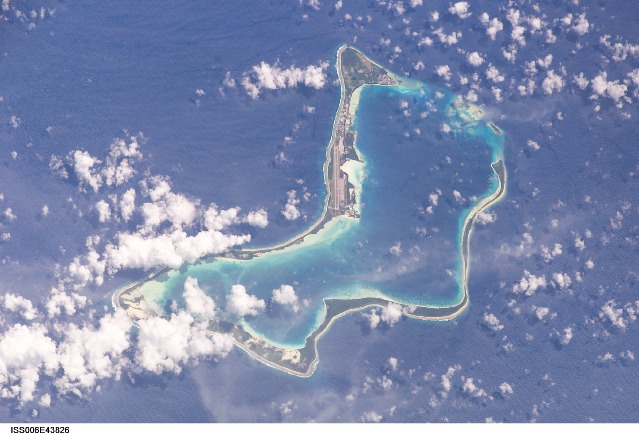
Photo 2. Diego Garcia. An Aerial View of two B-52 and six Kc-a135
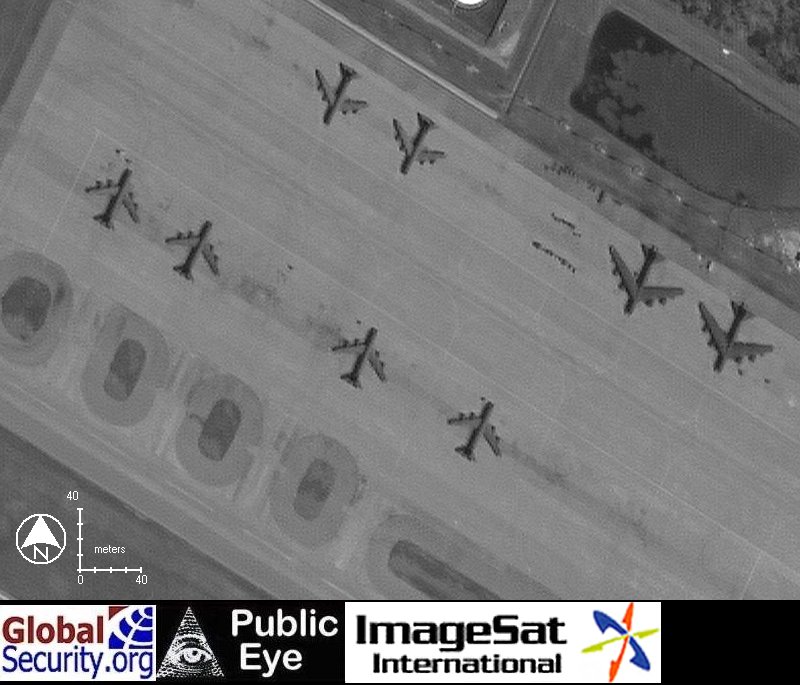
II. More than 1000 US Bases and/or Military Installations
The main sources of information on these military installations (e.g. C. Johnson, the NATO Watch Committee, the International Network for the Abolition of Foreign Military Bases) reveal that the US operates and/or controls between 700 and 800 military bases Worldwide. In this regard, Hugh d’Andrade and Bob Wing's 2002 Map 1 entitled "U.S. Military Troops and Bases around the World, The Cost of 'Permanent War'", confirms the presence of US military personnel in 156 countries. The US Military has bases in 63 countries. Brand new military bases have been built since September 11, 2001 in seven countries. In total, there are 255,065 US military personnel deployed Worldwide.
These facilities include a total of 845,441 different buildings and equipments. The underlying land surface is of the order of 30 million acres. According to Gelman, who examined 2005 official Pentagon data, the US is thought to own a total of 737 bases in foreign lands. Adding to the bases inside U.S. territory, the total land area occupied by US military bases domestically within the US and internationally is of the order of 2,202,735 hectares, which makes the Pentagon one of the largest landowners worldwide (Gelman, J., 2007).
Map 1. U.S. Military Troops and Bases around the World. The Cost of «Permanent War» and Some Comparative Data

Map 2. The American Military Bases Around the World (2001-2003)

Map 3 US Military Bases Click here to see Map 3
The Map of the World Network "No Bases" (Map 3) reveals the following:
Based on a selective examination of military bases in North America, Latin America, Western Europe, the Middle East, Central Asia, Indonesia, the Philippines and Japan, several of these military bases are being used for intelligence purposes. New selected sites are Spy Bases and Satellite-related Spy Bases.
The Surface of the Earth is Structured as a Wide Battlefield
These military bases and installations of various kinds are distributed according to a Command structure divided up into five spatial units and four unified Combatant Commands (Map 4). Each unit is under the Command of a General. The Earth surface is being conceived as a wide battlefield which can be patrolled or steadfastly supervised from the Bases.
Map 4. The World and Territories Under the Responsibility of a Combatant Command or Under a Command Structure
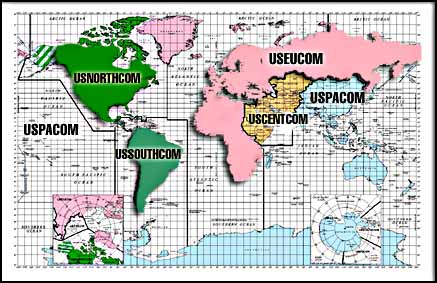
Territories under a Command are: the Northern Command (NORTHCOM) (Peterson Air Force Base, Colorado), the Pacific Command (Honolulu, Hawaii), the Southern Command (Miami, Florida – Map 5), The Central Command (CENTCOM) (MacDill Air Force Base, Florida), the European Command (Stuttgart-Vaihingen, Germany), the Joint Forces Command (Norfolk, Virginia), the Special Operations Command (MacDill Air Force Base, Florida), the Transportation Command (Scott Air Force Base, Illinois) and the Strategic Command (STRATCOM) (Offutt Air Force Base, Nebraska).
Map 5. The Southern Command
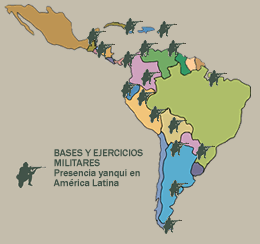
NATO Military Bases
The Atlantic Alliance (NATO) has its own Network of military bases, thirty in total. The latter are primarily located in Western Europe:
Whiteman, U.S.A., Fairford, Lakenheath and Mildenhall in United Kingdom, Eindhoven in Netherlands, Brüggen, Geilenkirchen, Landsberg, Ramstein, Spangdahlem, Rhein-Main in Germany, Istres and Avord in France. Morón de la Frontera and Rota in Spain, Brescia, Vicenza, Piacenza, Aviano, Istrana, Trapani, Ancora, Pratica di Mare, Amendola, Sigonella, Gioia dell Colle, Grazzanise and Brindisi in Italy, Tirana in Albania, Incirlik in Turkey, Eskan Village in Soudi Arabia and Ali al Salem in Koweit.
III. The Global Deployment of US Military Personnel
There are 6000 military bases and/ or military warehouses located in the U.S. Total Military Personnel is of the order of 1,4 million of which 1,168,195 are in the U.S and US overseas territories.
Taking figures from the same source, there are 325,000 US military personnel in foreign countries:
800 in Africa, 97,000 in Asia (excluding the Middle East and Central Asia), 40,258 in South Korea, 40,045 in Japan, 491 at the Diego Garcia Base in the Indian Ocean, 100 in the Philippines, 196 in Singapore, 113 in Thailand, 200 in Australia, and 16,601 Afloat.
In Europe, there are 116,000 US military personnel including 75,603 who are stationed in Germany. In Central Asia about 1,000 are stationed at the Ganci (Manas) Air Base in Kyrgyzstan and 38 are located at Kritsanisi, in Georgia, with a mission to train Georgian soldiers. In the Middle East (excludng the Iraq war theater) there are 6,000 US military personnel, 3,432 of whom are in Qatar and 1,496 in Bahrain. In the Western Hemisphere, excluding the U.S. and US territories, there are 700 military personnel in Guantanamo, 413 in Honduras and 147 in Canada.
Map 3 provides information regarding military personnel on duty, based on a regional categorization (broad regions of the world). The total number of military personnel at home in the U.S. and/or in US Territories is 1,139,034. There are 1,825 in Europe 114, 660, 682 in Subsaharian Africa, 4, 274 in the Middle East and Southern Asia, 143 in the Ex-USSR, and 89,846 in the Pacific.
IV. The Operational Cost of the Worldwide Military Network
US defense spending (excluding the costs of the Iraq war) have increased from 404 in 2001 to 626 billion dollars in 2007 according to data from the Washington based Center for Arms Control and Non-Proliferation. US defense spending is expected to reach 640 billion dollars in 2008.
These 2006 expenses correspond to 3.7% of the US GDP and $935.64 per capita.
Figure 1. U.S. Military Expenditures since 1998

According to Fig 1, the 396 billion dollars military budget proposed in 2003 has in fact reached 417.4 billion dollars, a 73% increase compared to 2000 (289 billion dollars). This outlay for 2003 was more than half of the total of the US discretionary budget. Since 2003, these military expenditures have to be added to those of the Iraq war and occupation The latter reached in March 2007, according to the National Priorities Project, a cumulative total of 413 billion dollars. Estimates of the Defense Department budget needs, made public in 2006 in the DoD Green Book for FY 2007 are of the order of 440 billion dollars.
Military and other staff required numbered 1,332,300. But those figures do not include the money required for the "Global World on Terrorism" (GWOT). In other words, these figures largely pertain to the regular Defense budget. A Goldstein of the Washington Post, within the framework of an article on the aspects of the National 2007 budget titled «2007 Budget Favors Defense», wrote about this topic: "Overall, the budget for the 2007 fiscal year would further reshape the government in the way the administration has been striving to during the past half-decade: building up military capacity and defenses against terrorist threats on U.S. soil, while restraining expenditures for many domestic areas, from education programs to train service"
V. US Military Bases to Protect Strategic Energy Resources
In the wake of 9/11, Washington initiated its "Global War on Terrorism" (GWOT), first in Afghanistan and then in Iraq. Other countries, which were not faithfully obeying Washington's directives including Iran, North Korea, Syria and Venezuela have been earmarked for possible US military intervention. Washington keeps a close eye on countries opposed to US corporate control over their resources. Washington also targets countries where there are popular resistance movements directed against US interests, particularly in South America. In this context, President Bush made a quick tour to Brazil, Uruguay, Colombia, Guatemala and Mexico «to promote democracy and trade» but also with a view to ultimately curbing and restraining popular dissent to the US interests in the region.
The same braod approach is being applied in Central Asia. According to Iraklis Tsavdaridis, Secretary of the World Peace Council (WPC):
"The establishment of U.S. military bases should not of course be seen simply in terms of direct military ends. They are always used to promote the economic and political objectives of U.S. capitalism. For example, U.S. corporations and the U.S. government have been eager for some time to build a secure corridor for US.-controlled oil and natural gas pipelines from the Caspian Sea in Central Asia through Afghanistan and Pakistan to the Arabian Sea. This region -has more than 6 percent of the world's proven oil reserves and almost 40 percent of its gas reserves. The war in Afghanistan and the creation of U.S. military Bases in Central Asia are viewed as a key opportunity to make such pipelines a reality."
The US. are at War in Afghanistan and Iraq. They pursue these military operations until they reach their objective which they call "VICTORY". According to Wikipedia, American troops fighting in these countries number 190,000. The "Enduring Freedom" Operation in Iraq alone has almost 200,000 military personnel, including 26,000 from other countries participating to the US sponsored "Mission". About 20,000 more could join other contingents in the next few months. In Afghanistan, a total of 25,000 soldiers participate to the operation (Map 6 and Map 7).
Map 6. Petroleum and International Theatre of War in the Middle East and Central Asia

Map 7. American Bases Located in Central Asia

Map 8. Oil Fields in Latin America
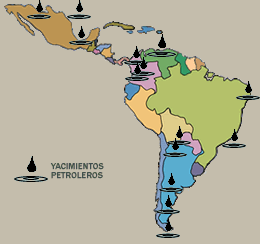
VI. Military Bases Used for the Control of Strategic Renewable Resources
US Military Bases in foreign countries, are mainly located in Western Europe: 26 of them are in Germany, 8, in Great Britain, and 8 in Italy. There are nine military installations in Japan (Wikepedia). In the last few years, in the context of the GWOT, the US haa built 14 new bases in and around the Persian Gulf. It is also involved in construction and/or or reinforcement of 20 bases (106 structured units as a whole) in Iraq, with costs of the order of 1.1 billion dollars in that country alone (Varea, 2007) and the use of about ten bases in Central Asia. The US has also undertaken continued negotiations with several countries to install, buy, enlarge or rent an addional number of military bases. The latter pertain inter alia to installations in Morocco, Algeria, Mali, Ghana, Brazil and Australia (See Nicholson, B., 2007), Poland, Czech Republic (Traynor, I., 2007), Ouzbekistan, Tadjikistan, Kirghizstan, Italy (Jucca, L., 2007) and France.
Washington has signed an agreement to build a military base in Djibouti (Manfredi, E., 2007). All these initiatives are a part of an overall plan to install a series of military bases geographically located in a West-East corridor extending from Colombia in South America, to North Africa, the Near East, Central Asia and as far as the Philippines (Johnson, C., 2004). The US bases in South American are related to the control and access to the extensive natural biological , mineral and water resources resources of the Amazon Basin. (Delgado Jara, D., 2006 and Maps 9 and 10).
Map 9. The Biological Wealth of Latin America
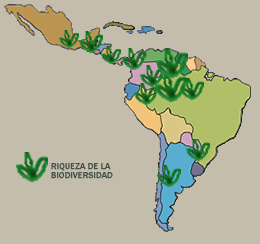
Map 10. Freshwater Resources in Latin America

VII. Resistance Movements
The network of US military bases is strategic, located in prcximity of traditional strategic resources including nonrenewable sources of energy. This military presence has brought about political opposition and resistance from progressive movements and antiwar activists. Demonstrations directed against US military presence has developed in Spain, Ecuador, Italy, Paraguay, Uzbekistan, Bulgaria and in many other countries. Moreover, other long-termer resistance movements directed against US military presence have continued in South Korea, Puerto Rico, Guam, the Philippines, Cuba, Europe, Japan and other locations.
The Worldwide resistance to US foreign military bases has grown during the last few years. We are dealing with an International Network for the Abolition of US Military Bases. Such networks' objective is to broadly pursue disarmament, demilitarization processes Worldwide as well as dismantle US military bases in foreign countries. The NO BASES Network organizes educational campaigns to sensitize public opinion. It also works to rehabilitate abandoned military sites, as in the case of Western Europe. These campaigns, until 2004, had a local and national impact.
The network is now in a position to reach people Worldwide. The network itself underscores that "much can be gained from greater and deeper linkages among local and national campaigns and movements across the globe. Local groups around the world can learn and benefit from sharing information, experiences, and strategies with each other"
"The realisation that one is not alone in the struggle against foreign bases is profoundly empowering and motivating. Globally coordinated actions and campaigns can highlight the reach and scale of the resistance to foreign military presence around the world. With the trend of rising miniaturization and resort to the use of force around the world, there is now an urgent and compelling need to establish and strengthen an international network of campaigners, organisations, and movements working with a special and strategic focus on foreign military presence and ultimately, working towards a lasting and just system of peace»
The Afghanistan and Iraq wars have, in this regard, created a favourable momentum, which has contributed to the reinforcement of the movement to close down US military bases in foreign countries: "At the time of an International anti-war meeting held in Jakarta in May 2003, a few weeks after the start of the Iraq invasion, a global anti-military Bases campaign has been proposed as an action to priorize among global anti-war, justice and solidarity movements»
Since then, the campaign has acquired greater recognition. E-mail lists have been compiled that permit the diffusion of the movement members experiences and information and discussion exchanges. That list now groups 300 people and organizations from 48 countries. A Web site permits also to adequately inform all Network members. Many rubrics provide highly valuable information on ongoing activities around the World.
In addition, the Network is more and more active and participates in different activities. At the World Social Forums it organized various conferences and colloquia. It was present at the European Social Forum held in Paris in 2003 and in London in 2004 as well as at the the America’s Social Forum in Ecuador in 2004, and at the Mediterranean Social Forum in Spain in 2005.
One of the major gatherings, which was held in Mumbai, India, in 2004, was within the framework of the World Social Forum. More than 125 participants from 34 countries defined the foundations of a coordinated global campaign. Action priorities were identified, such as the determination of a global day of action aiming at underscoring major issues stemming from the existence of US military bases. The Network also held four discussion sessions at the Porto Alegre Social Forum in 2005. One of those pertained to the financing of the Network's activities. It is important to recall that the Network belongs to the Global Peace Movement. Justice and Peace organizations have become more sensitized on what was at stake regarding US military bases. .
Map 11. Social and Resistence Movements in Latin America

The Quito and Manta International Conference, Ecuador, March 2007
A Network World Conference for the Abolition of Foreign Military Bases was held at Quito and at Manta, Ecuador, from March 5 to 9 2007
The objective of the Conference was to underscore the political, social, environmental and economic impacts of US military bases, to make known the principles of the various Anti-Bases movements and to formally build the Network, its strategies, structure and Action Plans. The main objectives of the Conference were the following:
- Analyze the role of Foreign Military Bases and other features of military presence associated to the global dominance strategy and their impacts upon population and environment;
- Share experiences and reinforce the built solidarity resulting from the resistance battles against Foreign military Bases around the World;
- Reach a consensus on objectives mechanisms, on action plans, on coordination, on communication and on decision making of a Global Network for the abolition of all Foreign military Bases and of all other expressions of military presence; and
- Establish global action plans to fight and reinforce the resistance of local people and ensure that these actions are being coordinated at the international level.
Conclusion
This article has focussed on the Worldwide development of US military power. The US tends to view the Earth surface as a vast territory to conquer, occupy and exploit. The fact that the US Military splits the World up into geographic command units vividly illustrates this underlying geopolitical reality. Humanity is being controlled and enslaved by this Network of US military bases. . The ongoing re-deployment of US troops and military bases has to be analyzed in a thorough manner if we wish to understand the nature of US interventionism in different regions of the World.
This militarisation process is charactersied by armed aggression and warfare, as well as interventions called "cooperation agreements". The latter reaffirmed America's economic design design in the areas of trade and investment practices. Economic development is ensured through the miniaturization or the control of governments and organizations. Vast resources are thereby expended and wasted in order to allow such control to be effective, particuarly in regions which have a strategic potential in terms of wealth and resources and which are being used to consolidate the Empire's structures and functions.
The setting up of the International Network for the Abolition of Foreign Military Bases turns out to be an extraordinary means to oppose the miniaturization process of the Planet. Such Network is indispensable and its growth depends on a commitment of all the People of the World. It will be extremely difficult to mobilize them, but the ties built up by the Network among its constituant resistence movements are a positive element, which is ultmately conducive to more cohesive and coordinated battle at the World level.
The Final Declaration of the Second International Conference against Foreign Military Bases which was held in Havana in November 2005 and was endorsed by delegates from 22 countries identifies most of the major issues, which confront mankind. This Declaration constitutes a major peace initative. It establishes international solidarity in the process of disarmament.
<REAL conclusion: The US government is the Evil Empire.>
Asking a Judge to Save the World, and Maybe a Whole Lot More

Part of a detector to study results of proton collisions by a particle accelerator that a federal lawsuit filed in Hawaii seeks to stop.
None of this nor the rest of the grimness on the front page today will matter a bit, though, if two men pursuing a lawsuit in federal court in Hawaii turn out to be right. They think a giant particle accelerator that will begin smashing protons together outside Geneva this summer might produce a black hole or something else that will spell the end of the Earth — and maybe the universe.
Scientists say that is very unlikely — though they have done some checking just to make sure.
The world’s physicists have spent 14 years and $8 billion building the Large Hadron Collider, in which the colliding protons will recreate energies and conditions last seen a trillionth of a second after the Big Bang. Researchers will sift the debris from these primordial recreations for clues to the nature of mass and new forces and symmetries of nature.
But Walter L. Wagner and Luis Sancho contend that scientists at the European Center for Nuclear Research, or CERN, have played down the chances that the collider could produce, among other horrors, a tiny black hole, which, they say, could eat the Earth. Or it could spit out something called a “strangelet” that would convert our planet to a shrunken dense dead lump of something called “strange matter.” Their suit also says CERN has failed to provide an environmental impact statement as required under the National Environmental Policy Act.
Although it sounds bizarre, the case touches on a serious issue that has bothered scholars and scientists in recent years — namely how to estimate the risk of new groundbreaking experiments and who gets to decide whether or not to go ahead.
The lawsuit, filed March 21 in Federal District Court, in Honolulu, seeks a temporary restraining order prohibiting CERN from proceeding with the accelerator until it has produced a safety report and an environmental assessment. It names the federal Department of Energy, the Fermi National Accelerator Laboratory, the National Science Foundation and CERN as defendants.
According to a spokesman for the Justice Department, which is representing the Department of Energy, a scheduling meeting has been set for June 16.
Why should CERN, an organization of European nations based in Switzerland, even show up in a Hawaiian courtroom?
In an interview, Mr. Wagner said, “I don’t know if they’re going to show up.” CERN would have to voluntarily submit to the court’s jurisdiction, he said, adding that he and Mr. Sancho could have sued in France or Switzerland, but to save expenses they had added CERN to the docket here. He claimed that a restraining order on Fermilab and the Energy Department, which helps to supply and maintain the accelerator’s massive superconducting magnets, would shut down the project anyway.
James Gillies, head of communications at CERN, said the laboratory as of yet had no comment on the suit. “It’s hard to see how a district court in Hawaii has jurisdiction over an intergovernmental organization in Europe,” Mr. Gillies said.
“There is nothing new to suggest that the L.H.C. is unsafe,” he said, adding that its safety had been confirmed by two reports, with a third on the way, and would be the subject of a discussion during an open house at the lab on April 6.
“Scientifically, we’re not hiding away,” he said.
But Mr. Wagner is not mollified. “They’ve got a lot of propaganda saying it’s safe,” he said in an interview, “but basically it’s propaganda.”
In an e-mail message, Mr. Wagner called the CERN safety review “fundamentally flawed” and said it had been initiated too late. The review process violates the European Commission’s standards for adhering to the “Precautionary Principle,” he wrote, “and has not been done by ‘arms length’ scientists.”
Physicists in and out of CERN say a variety of studies, including an official CERN report in 2003, have concluded there is no problem. But just to be sure, last year the anonymous Safety Assessment Group was set up to do the review again.
“The possibility that a black hole eats up the Earth is too serious a threat to leave it as a matter of argument among crackpots,” said Michelangelo Mangano, a CERN theorist who said he was part of the group. The others prefer to remain anonymous, Mr. Mangano said, for various reasons. Their report was due in January.
This is not the first time around for Mr. Wagner. He filed similar suits in 1999 and 2000 to prevent the Brookhaven National Laboratory from operating the Relativistic Heavy Ion Collider. That suit was dismissed in 2001. The collider, which smashes together gold ions in the hopes of creating what is called a “quark-gluon plasma,” has been operating without incident since 2000.
Mr. Wagner, who lives on the Big Island of Hawaii, studied physics and did cosmic ray research at the University of California, Berkeley, and received a doctorate in law from what is now known as the University of Northern California in Sacramento. He subsequently worked as a radiation safety officer for the Veterans Administration.
Mr. Sancho, who describes himself as an author and researcher on time theory, lives in Spain, probably in Barcelona, Mr. Wagner said.
Doomsday fears have a long, if not distinguished, pedigree in the history of physics. At Los Alamos before the first nuclear bomb was tested, Emil Konopinski was given the job of calculating whether or not the explosion would set the atmosphere on fire.
The Large Hadron Collider is designed to fire up protons to energies of seven trillion electron volts before banging them together. Nothing, indeed, will happen in the CERN collider that does not happen 100,000 times a day from cosmic rays in the atmosphere, said Nima Arkani-Hamed, a particle theorist at the Institute for Advanced Study in Princeton.
What is different, physicists admit, is that the fragments from cosmic rays will go shooting harmlessly through the Earth at nearly the speed of light, but anything created when the beams meet head-on in the collider will be born at rest relative to the laboratory and so will stick around and thus could create havoc.
The new worries are about black holes, which, according to some variants of string theory, could appear at the collider. That possibility, though a long shot, has been widely ballyhooed in many papers and popular articles in the last few years, but would they be dangerous?
According to a paper by the cosmologist Stephen Hawking in 1974, they would rapidly evaporate in a poof of radiation and elementary particles, and thus pose no threat. No one, though, has seen a black hole evaporate.
As a result, Mr. Wagner and Mr. Sancho contend in their complaint, black holes could really be stable, and a micro black hole created by the collider could grow, eventually swallowing the Earth.
But William Unruh, of the University of British Columbia, whose paper exploring the limits of Dr. Hawking’s radiation process was referenced on Mr. Wagner’s Web site, said they had missed his point. “Maybe physics really is so weird as to not have black holes evaporate,” he said. “But it would really, really have to be weird.”
Lisa Randall, a Harvard physicist whose work helped fuel the speculation about black holes at the collider, pointed out in a paper last year that black holes would probably not be produced at the collider after all, although other effects of so-called quantum gravity might appear.
As part of the safety assessment report, Dr. Mangano and Steve Giddings of the University of California, Santa Barbara, have been working intensely for the last few months on a paper exploring all the possibilities of these fearsome black holes. They think there are no problems but are reluctant to talk about their findings until they have been peer reviewed, Dr. Mangano said.
Dr. Arkani-Hamed said concerning worries about the death of the Earth or universe, “Neither has any merit.” He pointed out that because of the dice-throwing nature of quantum physics, there was some probability of almost anything happening. There is some minuscule probability, he said, “the Large Hadron Collider might make dragons that might eat us up.”
20080329
Science project sparks subway scare
NEW YORK (AP) -- A college student has apologized for causing a scare on a subway train when his science project short-circuited and started smoking in his backpack.
Gregory Kats, 29, said the device was just a model of an elevator's inner workings. But it frightened riders on a B train near the Seventh Avenue stop on Thursday.
Kats said he tried to reassure his fellow passengers that it was a school project -- not a bomb -- but people scrambled for the exits nonetheless. The box he was holding had a small battery, wires and a motor.
"They were panicking, and I realized their fear," an apologetic Kats said.
He said he tried to disassemble the contraption on the platform even as he reassured riders, "Don't worry. This is my science project."
Kats was questioned by police and later released.
Kats is a computer engineering student at the New York City College of Technology.
"I'm very sorry for what happened," Kats said. "I hate to scare people. Next time, I'll be much more careful and keep my electronic projects at home."<Disgusting. Shame on all of them, cops, citizens and student.>
Outrage and Controversy at NY Museum Art Show Depicting Police Brutality
By Dread Scott
"Taxpayer dollars certainly should not fund any art that promotes hate, and that's certainly what [Dread Scott's, Blue Wall of Violence] does." Patrick Lynch, president, NYC Patrolmen's Benevolent Association
My exhibition Dread Scott: Welcome to America opened on February 28 at MoCADA (the Museum of Contemporary African Disporan Art) in Brooklyn, NY. It is a survey of my art spanning almost two decades. The show was instantly vilified in the NY Daily News and the police union called for the city and state to defund the museum because of one of the works. Specifically, they denounced "The Blue Wall of Violence." In its Feb. 29 article bearing the headline "Finest: Dis Art is the Worst!" the News wrote: "A cop-bashing art exhibit at a taxpayer-funded museum in Brooklyn portrays the city's Finest as trigger-happy racists who have put bull's-eyes on the backs of black New Yorkers."
"The Blue Wall of Violence" is a 1999 installation that addresses police brutality. It focuses on the object that the police "mistook" for a dangerous weapon when they shot an unarmed person. The artwork consists of several elements: On the wall are six actual FBI silhouette targets which police use for shooting practice. Protruding from each of these is a cast of an arm. In each hand is an object -- wallet, house keys, 3 Musketeers bar, squeegee, etc. Above each target is a date. In front of this is a coffin and in front of the coffin are three police batons which are moved by motors so that they each strike the casket every 10 seconds with a loud penetrating bang. The dates correspond to a day when an actual person was shot by the police and the objects are what they were holding when shot (For example, on February 4, 1999 Amadou Dialo was shot 41 times while holding his wallet, on Sept 24, 1994, 13-year-old Nicholas Hayward Jr. was killed while holding a brightly colored oversized water pistol ...)
In many of my artworks, I use common objects that have a particular resonance from everyday life. In this case, targets, coffins and billy clubs are combined and people can see something new about them. In another work in the exhibit I have a Black baby doll floating in an aquarium and place a trumpet at the bottom -- all in reference to Hurricane Katrina. My works tend to have a horrible beauty and that tension is what I think contributes to their power.
This work stylizes these six targets and a coffin to point to the tip of a much larger iceberg. When I made the piece in at the end of the 90s the police and law enforcement had killed over 2,000 people that decade. And this statistic has rapidly increased in the past 8 years.
The news story that has developed has focused on one artwork. What is overshadowed in all of this is that "The Blue Wall of Violence" is part of a larger exhibition that explores many themes. It includes work about people left to suffer and die in Katrina, people killed by the U.S. war on Afghanistan, brutality against Muslims while in detention after 9-11 and photographs and audio interviews with some of the 2.4 million prisoners in the U.S.
Police brutality in the U.S. is part of this larger picture. In considering what work would be included in the exhibition, I thought about what would enable my audience to think about some particular theme or subject addressed by individual works as well as to be able to muse about broader relationships. For example what is the relation between a Guinean immigrant being drawn to America and later killed by the police in the doorway to his Bronx apartment and children killed by U.S. bombs in Afghanistan?
A couple of people who visited the exhibit recently noted that I say, "I make revolutionary art to propel history forward" and wanted to know more about what I meant by that. The conversation touched on a range of things, but one thing I pointed out was that the world is a horror for billions of people. Many of the works in this exhibit highlight what this means for Black people and reveal how this society literally kills us.
I want my audience to engage the misery that this system causes for so many as well as dream about how it could be radically different. One work, "Imagine a World Without America" encourages the viewer to do just that. The title is from Bob Avakian, Chairman of the Revolutionary Communist Party, U.S.A, who has inspired my thinking and influenced my work for 20 years. We need systemic change from bottom to top and I would like my art to contribute to society getting beyond a world where a tiny handful controls the great wealth and knowledge that humanity as a whole has created.
But many of these broader themes have been lost in how the discourse around this exhibit has been framed. That said, it is important to look at this controversy in its own right. In my opinion, the police response has done nothing but affirm the themes in the show. What kind of society do you have when cops not only have unrestrained power to shoot unarmed people but then demand that artists and museums that shine the light on these crimes be punished? And in case anyone has any illusions that this is "just" about arts funding, it is revealing to learn how the police speak about this when they think that they are "off the record." Below are some of the responses posted on policelink.com -- a social networking site for police across the country.
NYPDLieutenant: (Retired from the NYPD in 2004 as a lieutenant) "The Brooklyn "Museum" should be blown off the face of the earth. It's the most liberal, anti-American, racist spot in the entire city."
KD7LBP: (Deputy Sheriff: Oregon City, OR) "Judging from his work I would say that he probably should go back to his country of origin since he doesnt like living in the United States. I bet if he tried to "express" his freedom there he would find out just how "oppressive" the government can really be."
tony6d2: (Assistant Chief Firearms Training Officer/Armor in FL) "Ha! Figures this shit would be in Brooklyn! I've always hated fucking Brooklyn! That museum would have been burnt down to the ground in Howard Beach, Queens and then afterwards everybody would have met up at the local Trattoria for Capicolla and Canolis! ... This is why people end up getting chased into the Belt Parkway by other people with baseball bats!"
FYI, tony62d2's Belt Parkway comment refers to the 1986 racist bat-wielding mob who screamed "get the nigger" as they chased Michael Griffith onto a busy highway where he was struck by a car and killed.
I also received the following e-mail: "You are nothing but a racist piece of human garbage, I really hope you drop dead: God forgive that you would ever need a police officer for any type of crime that would happen to you, maybe we will get lucky and some piece of shit black man will shoot you. go to HELL ASSHOLE"
I hope people think about what it means to have people like this, armed and with the authority of the State, confronting Black people holding house keys, wallets or candy bars. What does it mean when they are sent to New Orleans? What does it mean when they arrest Arabs after 9/11? What does it mean when they fly "missions" above villages in Afghanistan or Iraq? These are questions I think about when I make art. And I want people to question whether any basic change for the better can come as long as you have this system in place.
The controversy has been covered on all local TV news stations, on the radio, on blogs and has received very positive Spanish language coverage on prominent websites in Chile, Yahoo Mexico and elsewhere. And people who have actually seen the show have been very enthusiastic.
I'm very proud of Dread Scott: Welcome to America. It is a powerful and apparently more thought-provoking exhibition than either I or the museum expected. MoCADA and its supporters have taken a courageous stand and are not backing down in the face of the very real threats. If you are in the area, I hope you will come see the exhibit. It is on view until June 1. I will be giving an artist talk at the Museum this Thursday March 13. And if you are outside the NY area, much of the work is available to view on my website.
At Supreme Court: Americans accused in Iraq want U.S. judge
Do citizens held by the US military in a foreign war have constitutional protections?
By Warren RicheyWashington - When an American commits a crime overseas he or she is subject to arrest and prosecution under the laws of that foreign country.
But what happens when the country is Iraq and the detaining authority is the US military? Can the US government turn one of its own citizens over to Iraqi authorities for harsh interrogations, criminal prosecution, and a potential death sentence?
That's the circumstance that arose in two different cases of Americans detained by the US military in Iraq. American judges are in disagreement about how to treat such cases. On Tuesday, the issue arrives at the US Supreme Court.
The primary question is whether United States citizens being held by the US military in a foreign war zone are entitled to constitutional protections – including the right to have a neutral American judge examine the legality of his or her detention.
The two US citizens, Mohammad Munaf and Ahmed Omar, are accused of involvement in plots to kidnap and ransom foreigners in Iraq. Both say they are innocent.
Government lawyers say the two men are merely trying to use the US courts to avoid having to answer in Iraq for their alleged crimes.
Lawyers for the two disagree. "The issue is not: Do you let these guys go or not?" said Aziz Huq of the Brennan Center for Justice at New York University during a recent briefing with reporters. "The issue is, can they come into court and say, 'You've got [the facts] wrong.' "
Mr. Huq added, "This is about whether the courthouse doors are open."
Mr. Munaf is a dual US-Iraqi citizen. He is suspected of plotting with Iraqi gunmen who kidnapped and ransomed three Romanian journalists in March 2005. Munaf had been hired by the journalists as a translator and guide.
When the journalists were released, Munaf was seized by the US military and held without charge in an American detention camp in Baghdad. Lawyers working on Munaf's behalf challenged the legality of his open-ended detention by filing a habeas corpus petition with a federal judge in Washington.
The US responded to those legal efforts by referring Munaf's case to Iraqi authorities.
Munaf's lawyers complained that as a Sunni Muslim, their client would face a risk of torture at the hands of Iraqi investigators working to obtain a full confession.
According to the government's brief in the case, "Munaf admitted on camera, in writing, and in front of the Iraqi investigative court that he participated as an accomplice in the kidnapping for profit of the Romanian journalists."
But the brief also notes that Munaf recanted his confession at trial, saying the statements had been coerced. Nonetheless, he and five codefendants were convicted and sentenced to "execution by hanging until death."
Then, in February, an Iraqi appeals court threw out Munaf's conviction and death sentence. It ordered more investigation.
In the meantime, Munaf has remained in US military custody.
Both a federal judge and a federal appeals court panel have ruled against Munaf. They ruled that since US troops are part of a multinational force authorized by the United Nations, Munaf's detention overseas in Iraq is not within the jurisdiction of the US courts.
The second case involves Mr. Omar, a citizen of both the US and Jordan. Omar moved with his wife and six children to Baghdad, seeking work in the reconstruction of Iraq.
In 2004, US forces raided Omar's Baghdad home. According to the government's brief in the case, they discovered an Iraqi "insurgent" and four Jordanian "jihadist fighters" staying with the Omars. The brief says the men admitted to a plan in which Omar would use his knowledge of English to lure foreigners to his home where the "jihadists" would kidnap them and demand ransom. Some of the men later recanted statements implicating Omar, the government's brief says.
Omar has been held in US military custody without charge. He had been denied access to his wife, the US consul, and a lawyer.
In December 2005, Mrs. Omar filed a habeas petition asking a federal judge in Washington to rule on the legality of her husband's continued detention. The petition also asked the judge to prevent the US military from transferring Omar to Iraqi jurisdiction for a trial until a US court could rule on the lawfulness of his ongoing detention.
Unlike the Munaf case, the federal judge in Omar's case ruled that US courts have jurisdiction to examine such cases. In addition, the judge ordered the US government not to transfer Omar to Iraqi custody until the pending issues were resolved. A federal appeals court panel upheld the order.
Lawyers for Munaf and Omar are urging the Supreme Court to find that US courts have jurisdiction to hear petitions filed by Americans held by the US military overseas.
The US government seeks a "blank check" over the rights of the nation's citizens in its actions in Iraq, writes Joseph Margulies, a law professor at Northwestern University, in his brief on behalf of Omar and Munaf.
"Omar and Munaf are US citizens who have been detained for years by US officers at a US prison," Mr. Margulies writes. "Having done no wrong, they seek only what is guaranteed to all American citizens ...: the opportunity to test the lawfulness of their continued confinement in federal court."
The solicitor general's office counters that US forces are functioning in Iraq under a UN mandate and that US courts do not have jurisdiction to police such international efforts.
"Because individuals held pursuant to international authority are not in custody under ... the authority of the United States, the writ of habeas corpus does not extend to them," writes Solicitor General Paul Clement. "Omar and Munaf are held overseas pursuant to international authority by United States forces acting as part of a multinational force," he says.
The government also argues that since the two men traveled voluntarily to Iraq and allegedly committed crimes in Iraq, they are within the jurisdiction of Iraq's criminal-justice system. Since they were detained within Iraq, turning them over to Iraqi authorities does not trigger the extra layer of legal protections that exist during an extradition, Clement says.
Sentence not lost in translation
Judge orders four to learn English or go to jail
By David Weiss
WILKES-BARRE – Learn English or go to jail.
That’s the succinct directive Luzerne County Judge Peter Paul Olszewski Jr. made as part of his sentence to four criminals on Tuesday.
The defendants – Luis Reyes, Ricardo Dominguez, Kelvin Reyes-Rosario and Rafael Guzman-Mateo – all needed translators when they appeared in court to plead guilty to criminal conspiracy to commit robbery. It led to Olszewski leveling the unusual condition.
He sentenced them each to four to 24 months in the county prison, but paroled three of them because they have already served at least four months.
But in order for them to avoid the 24 months in prison, Olszewski ordered the men to learn to read and write the English language, earn their GED, and, within 30 days of release, get a full-time job while on parole. The defendants, who range in age from 17 to 22, are to return to court in one year with their parole officers to take an English test, according to Olszewski’s order.
“If they don’t pass, they’re going in for the 24 (months),” Olszewski said.
The ruling, the judge said, is supposed to help, not punish.
“There’s no way young kids can be hurt by knowing how to read and write the English language,” he said. “It’s a means to helping them get a better education, getting a better job. Period.”
Whether the legality of the ruling will be challenged has yet to be determined.
Attorneys Joseph Yeager and Ferris Webby, who represent the suspects, are looking at the ruling and laws before deciding whether to appeal. Neither has seen such an order in any past cases, they said.
“First of all, let’s say it’s unusual,” Webby said.
Webby said his role as an attorney requires him to look at the legality of the ruling, but, as a person, he knows Olszewski’s choice is good for his client, Guzman-Mateo.
Guzman-Mateo realizes it, too.
“My client is happy,” Webby said. “I think it’s going to help him. It’s going to help him succeed.”
But that doesn’t make it right, said Agapito Lopez, a Latino community leader from Hazleton. He said he believes the ruling is a violation of the suspects’ rights.
“I think that it’s contrary to the Constitution,” said Lopez, who stressed he is not an attorney and is speaking from a lay person’s perspective. “I don’t think that is due process. … I think this can be challenged in court.”
Lopez said he will speak with attorneys from the American Civil Liberties Union to see if the decision should be challenged.
Police said the four were part of a group of people that approached two men, Reese Tankalavage and Cletus Mumie, on May 29 on Locust Street and asked them if they had any marijuana. When Tankalavage and Mumie said no, the four suspects told them to empty their pockets. That’s when one of the people in the group struck Mumie in the head with a rawhide bone. Another man pulled out a gun.
The group then searched the duo’s pockets before telling them it was “their block and they better not see them around there anymore,” police said.
In sentencing the four defendants on Tuesday, Olszewski gave Reyes, Dominguez and Guzman-Mateo immediate parole. Reyes-Rosario is doing jail time on an unrelated drug charge. His sentence in the robbery case will begin after he completes the drug sentence.
Olszewski said the language condition he imposed on the defendants, who are resident aliens, was not something he had planned. Once he saw all the translators in court for one case, the idea dawned on him.
The decision, he said, could help cut down on extreme costs associated with the paying for translators for each court appearance.
Plus, he said, one of the defendants only went to third grade; the others didn’t finish high school. Learning English will help them get their GED first, and then a job, he said.
“Do you think we are going to supply you with a translator all of your life?” he asked them.
Olszewski is ready to face any flak from the ruling.
“I’d like anyone to tell me that learning the English language is not a good thing,” he said. “I’d love to hear from them.”
Learning the language could help the suspects, Lopez said. But it would not assure them of getting a job – that theory is merely mythical, he said.
“This is a country in which English is not the official language,” he said. “We cannot force people to learn the language.”
Olszewski said the parties can ask him to reconsider the ruling within 10 days. No one, he said, objected to the ruling in court Tuesday. Olszewski is unaware of whether this condition had been previously imposed.
It’s not the first creative sentence Olszewski has imposed. He regularly orders defendants to get and maintain a full-time job, but also helps them find work. He has his tipstaff, Ron Zukosky, coordinate with an employment agency to find the defendants work. The judge also has ordered young defendants who dropped out of school to return and finish school.
“There’s no way young kids can be hurt by knowing how to read and write the English language.”

